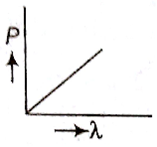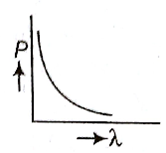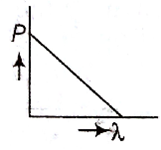 Multiple Choice Questions
Multiple Choice QuestionsWhen a metallic surface is illuminated with radiation of wavelength  , the stopping potential is V. If the same surface is illuminated with radiation of wavelength 2
, the stopping potential is V. If the same surface is illuminated with radiation of wavelength 2  , the stopping potential is V/4. The threshold wavelength for the metallic surface is,
, the stopping potential is V/4. The threshold wavelength for the metallic surface is,


3
3
A black body is at a temperature of 5760 K. The energy of radiation emitted by the body at wavelength 250 nm is U1, at wavelength 500 nm is U2 and that at 1000 nm is U3. Wien's constant, b = 2.88 x 106 nmK. Which of the following is correct?
U3 = 0
U1 > U2
U2 > U1
U2 > U1
A radiation of energy 'E' falls normally on a perfectly reflecting surface. The momentum transferred to the surface is
(c = velocity of light)




An electron of mass m and a photon have the same energy E. The ratio of de-Broglie wavelength associated with them is,




Which of the following figures represent the variation of particle momentum and the associated de-Broglie wavelength?




If the momentum of an electron is chagned by p, then the de-Broglie wavelenght associated with it changes by 0.5%. The initial momentum of electron will be
200p
400p
p/200
p/200
Two radiations of photon energies 1 eV and 2.5 eV, successively illuminate a photosensitive metallic surface of the maximum speeds of the emitted electrons is
1:4
1:2
1:1
1:1
An α- particle moves in a circular path of radius 0.83 cm in the presence of a magnetic field of 0.25 Wb/m2. The de-Broglie wavelength associated with the particle will be
1 Ao
0.1 Ao
10 Ao
10 Ao
Monochromatic radiation emitted when electron on hydrogen atom jumps from first excited to the ground state irradiates a photosensitive material. The stopping potential is measured to be 3.57 V. The threshold frequency of the material is
4 x 1015 Hz
5 x 1015 Hz
1.6 x1015 Hz
1.6 x1015 Hz
Light with an energy flux of 25 x 104 W/m2 falls on a perfectly reflecting surfaces at normal incidence. If the surface area is 15 cm2, the average force exerted on the surface is,
1.25 x 10-6 N
2.50 x 10-6 N
1.20 x 10-6 N
1.20 x 10-6 N
